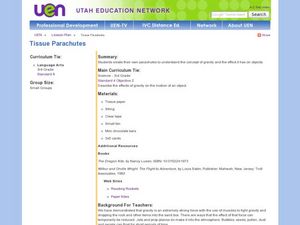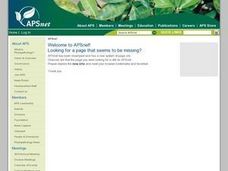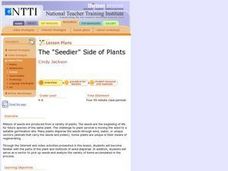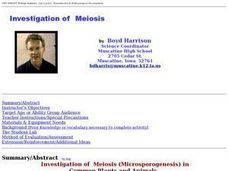Curated OER
Flower Power
Learners use video learning to explore how flowers make seeds and dissect their own flower, and make a flower with its reproductive parts out of construction paper.
Curated OER
Motion and Gravity
Third graders make parachutes to learn about gravity and the science process. In this gravity instructional activity, 3rd graders create parachutes and observe their flight in air. Students discuss wind and gravity for the activity.
Curated OER
I Breathe What?
Students participate in an experiment in which they gather and examine particiles in the air. They place pollution detectors at different locations and identify problem areas. They discuss how engineers can use this type of information...
Curated OER
Water Molds (Oomycetes)
Students explore a group of fungus-like organisms; the Oomycetes, by baiting them from natural sources (water and soil) and observing them.
Curated OER
Fun with Plants Flower Power
Students understand the parts of the flower. In this flower lesson, students perform experiments to see where seeds come from. Students complete a data sheet about the experiment. Students understand the terms pistil and stamen.
Curated OER
Flower Power
Students explore parts of the flower. In this plant biology lesson, students dissect flowers and identify how the seeds are formed. Students take a nature walk to pick flowers for future dissections.
Curated OER
The Great Pollinators
Students discover the reproductive parts of a plant. In this biology lesson, students identify and categorize several different plants they dissect in class. Students record their information using a data chart.
Curated OER
The "Seedier" Side of Plants
Students demonstrate seed dispersal vectors through role-play, analyze seed types, identify plant parts, list seven conditions plants need in order to grow, and describe how seeds travel.
Curated OER
Insects Are Helpful!
Students see that insects do lots good and are very valuable to humans and nature. This is part of an ongoing effort to dispel fears of insects. They rotate through a series of centers that have examples of how insects contribute to our...
Curated OER
Classifying Monocot And Dicot Plants
Sixth graders identify the parts of a flower, and tell the difference between monocots and dicots. They group plant by leaf types and characteristics placing the information in table form on the computer.
Curated OER
Indoor Air: What's the Matter?
Students investigate the variety and amount of particulate matter in the air. They locate the general sources of pollution for a specific area and develop some suggestions for improving air quality.
Curated OER
Investigation of Meiosis in Common Plants and Animals
Pupils witness various stages of mitosis through preparing onion root tip slides. With teacher guidance, they learn a great deal through the hands-on process of preparing the slides themselves.
Curated OER
The Angiosperms
Pupils study angiosperms and their classifications. In this investigative instructional activity students compare the sexual reproduction of angiosperms and seed formations.
Curated OER
LOOKING AT LAWNS
Students investigate the importance of plants to animals by exploring their own schoolyard. They record relevant observations, findings, and measurements, using written language, drawings, charts, and graphs. They describe ways in...
Curated OER
Living Corn Necklace
Fifth graders explore heredity and observable traits through experimentation. They view several different types of corn and record their observation of physical traits on a class chart. They create a corn necklace by sprouting dried...
















